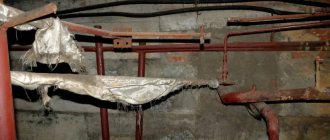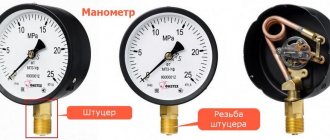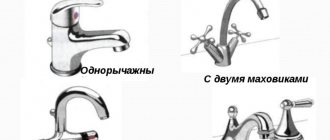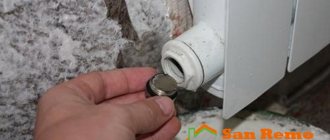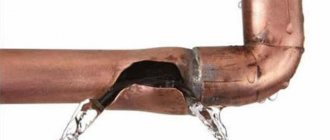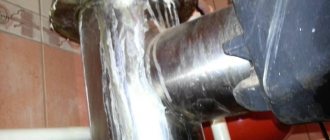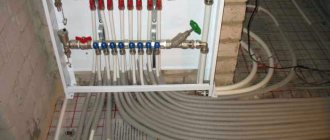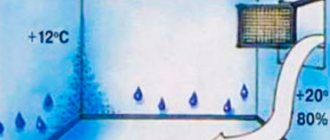Work to ensure the proper functioning of heating equipment does not end with its installation. Maintenance requires the owner to have a certain level of knowledge and constant monitoring of the condition of the system. It is important to understand why the pressure in a gas boiler drops or rises, which is why the equipment operates with fluctuations.
The article we presented describes in detail all the reasons for pressure instability in the coolant and hot water preparation system. We'll show you how to troubleshoot and keep your readings within normal range. Our recommendations will help you cope with emerging breakdowns and prevent operational failures.
What should be the pressure in the heating system?
Heating systems can be divided into two types - closed and open. When open, the pressure regulation function is performed by a leaky expansion tank.
The container is installed at the top point of the heating circuit and serves to hold the coolant expanding when heated, to remove air, and also acts as a safety valve. The operating pressure in such a system depends mainly on the temperature of the heating water.
Most often, when organizing heating in houses and apartments, closed heating systems are used. They are more effective and safe, but require constant pressure monitoring.
It is very important to monitor the pressure and temperature of the coolant, and respond to any signs that are not typical for the normal operation of the heating system - knocking, frequent discharge of hot water through the safety valve, cold sections of the circuit
The pressure in a closed-type circuit arises due to forced circulation carried out using a pump. Pressure deviations from the norm can lead to equipment failure.
The nominal pressure in gas boilers of different models may vary; it is determined by the technical characteristics of the equipment
When designing a heating system, the pressure is calculated taking into account the height of the water column, the length of the system, the characteristics of the connected equipment, and the cross-section of the pipes.
To adjust the working pressure, you need to focus on the following parameters:
- Technical characteristics of a gas boiler. The manufacturer indicates the capabilities of the equipment and its settings in the instructions.
- Coolant temperature. The higher the temperature, the greater the pressure in the circuit; as it decreases, it decreases. Therefore, setting and measuring the pressure in the gas boiler and heating circuit must be carried out before and after heating the coolant.
- Volume of the circuit and expansion tank. The size of the accumulator has a direct impact on the pressure in the heating circuit and the range of its fluctuation.
- Acceptable pressure indicators for the least “weak” element of the system. The pressure in the system should not exceed the permissible values for each of its elements. For example, polypropylene pipes, which on average are designed for a pressure of 25 bar at room coolant temperature, can withstand an increase in pressure only up to 7-9 bar at a temperature of 90 °C.
The minimum pressure in the circuit can be 0.5-0.8 bar, the exact standard values are indicated in the instructions, in accordance with them the pressure sensor is adjusted to the required value. If the pressure in the heating system drops below 0.5 bar, an emergency situation occurs, in which the gas boiler may stop or be damaged.
The highest pressure value in the system is up to 3, less often up to 4 bar. For a five-story building, pressure values are adjusted to 5 bar, for a ten-story building to 7 bar. When making settings, it is necessary to adhere to the difference in pressure between the outgoing and return pipes - it should be 0.3-0.5 bar. After starting the heating, check if this is the case.
Limiting Factors
For all types of modern pipes and radiators, a working pressure of at least 6 atmospheres is declared.
Polypropylene pipes. PN—working pressure in megapascals. In atmospheres it is equal (from top to bottom) 20, 16 and 25.
Why not raise the autonomous heating parameters to, say, 5 bar?
There are several reasons.
First and foremost: increased blood pressure will not provide any benefits. The height of the water column is needed only when filling an empty contour. It is easy to calculate that 1.5 atmospheres of excess pressure will raise the water by 15 meters. Given the legal limit on the height of private buildings to three floors, this is quite enough.
Private sector in Omsk
Pay attention to the number of floors of the building
Next: do not forget about the likelihood of force majeure (the same water hammer or pressure increase due to a malfunction of the safety valve). The safety margin of batteries and pipes in this case will come in very handy.
Finally: do not overestimate the strength and service life of pipes, primarily plastic pipes, which are popular in private housing construction. As the temperature rises, both drop quickly.
Inexpensive polypropylene pipes are a typical solution for autonomous heating.
If at room temperature polypropylene pipes PN25 honestly withstand the declared 25 atmospheres and serve the promised 50 years, then at 90C increasing the water pressure to 7-9 atmospheres may well lead to the destruction of the liner or bottling. Even if disaster does not happen, the resource of the material will be reduced to several months, or even weeks.
How to check the pressure in the boiler and circuit
System pressure is monitored using instruments that measure and display circuit pressure using a digital or mechanical dial. The sensors are installed by the manufacturer at the boiler outlet.
During the installation of the system, pressure gauges are also installed near the collectors, which distribute the coolant to various parts or floors of the building.
A safety group for boilers in the heating system helps control the temperature, pressure in the circuit, protects equipment from destruction by removing excess pressure outside
Additional pressure control is required when using boilers to heat water in underfloor heating systems. A drop or increase in pressure can be observed differently in different parts of the heating system.
A closed loop allows you to increase the pressure in the system, which increases its safety, since at higher pressure the boiling point of the liquid increases
When starting a gas boiler, check the pressure gauge while the heating water is still cold - the pressure should not be lower than the minimum value indicated by the red adjustable pressure gauge needle. The setup is carried out by a representative of the company with which a contract for service and gas supply has been concluded.
The initial setting is carried out when heating is started for the first time. In the future, the pressure is checked every week, and if necessary, the system is topped up with water. Make-up is carried out at a coolant temperature below 40 °C.
How to avoid problems
Although you can carry out the diagnosis yourself, you will spend a lot of time and effort. To repair your heating system, it is better to contact a specialized organization. Thanks to many years of experience and modern equipment, they quickly determine the cause of the malfunction and eliminate it.
You can avoid all these problems simply by following these recommendations:
- select the optimal and high-quality equipment, do not skimp and do not buy the cheapest - under high loads it will not be able to provide you with safety;
- carry out competent and high-quality installation of the heating system, in this case all components will operate within the operating load limits specified by the manufacturer;
- Carry out regular maintenance, at least once a year: before the heating season or immediately after it;
- Be sure to follow the manufacturer's requirements specified in the equipment instructions.
Only by observing all these points will you not only increase the service life of your equipment, but also be able to ensure its efficient and uninterrupted operation.
Reasons for the increase in pressure in a gas boiler
In addition to the pressure gauge readings, frequent discharge of water through the safety valve and blocking the operation of the device help to detect an increase in pressure in a gas boiler. Having determined high pressure, first of all, excess air is released through the Mayevsky taps and the boiler is turned off. There may be several reasons for malfunctions.
The normal upper pressure value is ensured by the system by discharging excess coolant through a safety valve into the drain
An increase in pressure in a gas boiler can be caused by damage to the partition of the secondary heat exchanger, which simultaneously serves to insulate and increase the contact area of two circuits - heating and hot water supply.
The secondary heat exchanger takes water from the heating circuit for preparing and supplying hot water in a double-circuit boiler. Damage to the partition leads to the forcing of water from the hot water circuit into the heating system, increasing the pressure in it.
The secondary heat exchanger serves to service the hot water supply system. Water for domestic hot water is heated as a result of contact with the coolant of the heating circuit. The system is protected from mixing the two circuits by a metal partition, damage to which leads to the exchange of liquids and disruption of normal pressure
Replacing the heat exchanger will solve the problem. You can carry out repairs yourself, but it is not advisable to do this, since interfering with the operation of gas equipment requires knowledge and experience in this area. In addition, repairing the boiler yourself will deprive you of the right to warranty service.
A malfunction of the automatic gas boiler or a loose pump impeller, which sucks in air, also increases the pressure in the gas boiler. Equipment malfunctions that lead to disturbances in normal pressure may be the result of a manufacturing defect, a breakdown of the control board, or an incorrectly configured system. Only a qualified technician can fix this kind of problem.
General information
Many users often ask the question: what pressure should be in the heating system in a private home? In order to answer this, you first need to determine the variations in pressure.
There are different types of pressure in the heating system:
- Dynamic pressure. Here the circulation pump acts as the main source of value: it starts working and pressure is generated.
- Static coolant pressure. The value of this indicator depends on the height of the coolant column in a stationary position, and the force with which it acts on the links of the heating devices. When making calculations, do not forget that a height of 10 meters forms one atmosphere.
- The operating pressure in the heating system is a combination of the values of the other two types described above. By observing this parameter, you will be confident in the uninterrupted, and most importantly, safe operation of the heating device.
The water jacket of the boiler, which is located on the lower level, is most loaded. If in a private house, the boiler room is located on the roof, then the strongest pressure occurs on the pipeline network at the very bottom.
Depending on how the coolant heats up when it is stationary, the water pressure in the system increases due to the fact that the amount of liquid itself increases. High performance is achieved when the circulation pump operates at the moment of formation of dynamic pressure, which is necessary for the movement of the coolant along the circuit.
In order to objectively assess the situation, it is necessary to measure the pressure force in the lowest section of the circuit. Therefore, when you are first designing a system, be sure to indicate at this point the need to install pressure gauges.
Increasing pressure in the heating circuit
What to do if the pressure in the heating system rises excessively?
First of all, you need to establish the cause, and there may be several of them:
- Incorrect filling of the contour, its airiness. Due to the rapid filling of the heating line, air pockets may form in it. To avoid this phenomenon, when starting the heating, it must be filled slowly.
- The circuit temperature is too high. Any increase in temperature and coolant leads to its expansion and increased pressure in the system. It is necessary to prevent too high an increase in order to protect heating equipment from critical loads.
- Stopping the flow of coolant. The reason may be blocked shut-off valves, clogged mud filter, or air locks.
To identify the problem area, you need to examine the entire contour step by step.
The filter must be checked and cleaned immediately after the boiler is started for the first time, and then again a week later. Next, scheduled checks and cleanings are carried out once a month or season, depending on the degree of contamination of the coolant
Leaks can be caused by a breakdown of the make-up valve - wear of the valve gasket, mechanical damage to parts, or scale trapped between the seat and the gasket. If the tap is leaking, then excess water flowing from the water supply system into the heating main increases the pressure in it, because the pressure in the cold water pipeline is always higher. It is necessary to tighten the tap or replace it if it is faulty.
Air locks are a common cause of problems in the heating system. These can be caused by malfunctions of the gas boiler itself, problems in the circuit or incorrect starting of the heating.
Restarting the system will help troubleshoot problems - slowly filling it with coolant, starting from the lowest point, until water flows from the top point of the circuit. All air bleed valves must be open. Airing the system can lead to both an increase and a decrease in pressure.
Pressure drop
An increase in pressure in closed heating systems is not the only problem; in some cases there is a sharp drop in operating pressure, and among the reasons why the pressure level drops, the following should be highlighted:
- hidden system leaks, corrosion, loose connections, leaking fittings;
- rupture of the tank membrane, which requires replacement or repair of equipment;
- pressure drops in the system are observed, if the nipple poisons, such an air leak leads to deflation of the tank, and this causes damage to the membrane;
- there are cracks on the boiler heat exchanger, which leads to coolant leakage;
- pressure drops associated with the appearance of air bubbles lead to a decrease in the overall temperature in the system and its shutdown;
- One of the reasons for the decrease in pressure may be a soured or slightly open tap used to discharge water into the sewer system.
The main reasons for low blood pressure
Common reasons why the pressure in a gas heating boiler drops are:
- Coolant leak. Damage to the heating line leads to a loss of tightness, loss of heating water and a decrease in pressure.
- Cracks in the heat exchanger. Leaks in the boiler itself will not only lead to a decrease in pressure, but can also provoke more serious equipment breakdowns and damage electronics.
- Rupture of the membrane in the expansion tank. Through damage to the rubber partition, liquid enters the air compartment and the pressure in the circuit decreases.
To determine the location of the leak in the system, it is fed to normal pressure and the circulation pump is stopped. Step by step, it is necessary to inspect the highway, identify the problem area and troubleshoot.
Why is pressure needed?
Pressure in a heating system is the process of the coolant acting on the walls of the boiler, pipes, and radiators. Before water fills the pipeline, it is equal to atmospheric pressure (1 bar). This indicator changes as soon as the liquid begins to be poured into the pipeline and warms up. The coolant expands, the pressure increases to normal levels.
Reliable and efficient operation of a heating structure depends on pressure values. It provides it with extremely high performance and ensures that energy reaches the pipeline of all apartments in a multi-story building. This parameter determines the speed of water flow and, accordingly, the intensity of the heat exchange process between the structural components of the heating system. Therefore, the higher its performance, the greater the efficiency of the heating system.
How does the operation of a hydraulic accumulator affect pressure?
Problems with the expansion tank that affect the pressure in the heating circuit are very common. Incorrectly calculated volume of the expansion tank is one of the most characteristic prerequisites.
Malfunctions can result from improper installation, low or high pressure in the air chamber of the tank, a damaged membrane - each of the reasons can lead to disruption of coolant circulation in the system.
Expansion tank: device features and volume
If a small volume tank is installed in the heating system, it cannot compensate for the expansion of heating water when heated. At a temperature of 85-95 °C, water expands by approximately 4% and its excess volume exits through the safety relief valve.
In order for the expanzomat to fully perform its compensatory function, its capacity for systems with a gas boiler must be at least 10 percent of the total volume of water in the circuit.
If you install a tank with a larger volume than normal, the pressure fluctuations will be even smaller. Reducing pressure differences has a positive effect on the operation of the system and the service life of heating equipment
Damage to the tank membrane leads to water completely filling its volume and the pressure in the circuit drops. If you fill the volume of the circuit by opening the make-up valve, this will create a new problem - when the coolant heats up, there will be no room for it to expand and the pressure in the system will increase more than normal. The situation can only be corrected by replacing the rubber partition.
The tank should only be installed on the return pipe, in front of the heating boiler. This way the tank will have minimal impact on the operation of the circulation pump, which is installed after the gas boiler. In addition, here the water temperature is lower and the negative impact on the pressure in the system and on the tank membrane will be less.
Setting the pressure in the air chamber
The pressure formed in the air chamber of the expansion chamber can also lead to an increase or decrease in pressure inside the heating system. You can check and pump up the air in the tank only if there is no coolant in the tank.
To do this, you need to shut off access to the common circuit using shut-off valves and drain the water through the drain. Then the pressure in the air chamber is measured and inflated/lowered to the required values.
You can check the pressure in the expansion tank using a car pressure gauge, and pump it up using a car pump.
To set the pressure of the expansion tank in the air chamber, it must be 0.5 bar higher than the expected maximum pressure in the system. After the pressure in the equalizing part of the tank is adjusted, fill the circuit with cold water to the expected pressure value.
Then the air is released from the air chamber until the pressure in the heating circuit and the tank begins to decrease simultaneously - here it is necessary to simultaneously monitor the pressure in the system and in the expansion tank.
In this phase, changes in indicators are little noticeable, so you must be prepared to immediately stop bleeding air from the expansion tank as soon as a simultaneous decrease is detected.
CALCULATION OF MEMBRANE EXPANSION TANK
In some cases, the pressure drop in the heating system is associated with the wrong choice of a double-circuit boiler. Thermal calculations take into account the area of the premises that need to be heated. Based on these conditions, the power of the heating device is selected. The calculation takes into account ordinary radiators, in which the volume of water is not very large. And if metal pipes are used instead of radiators, several times more liquid is required to fill them, and accordingly, the volume of expanded water will also be increased.
The expansion tank in double-circuit boilers is usually 6-8 liters. It is designed for approximately 120 liters of water in the heating system. This is quite enough for radiators. But what can happen if there is more water in the system than it should be according to calculations. Let's say that the liquid, heating up in the pipes, expands and fills the standard expansion tank. But the size of the tank is not enough to remove excess heated water, the pressure rises and an emergency release occurs through the safety valve. After the boiler turns off, water from the tank comes back into the system, but since the boiler had an emergency discharge, there is not enough liquid in the system, the pressure drops below a critical level. That’s it, without replenishing the system with water (that is, without human intervention), the boiler will not turn on. If the air temperature outside is low, defrosting of the system is ensured. Moreover, this can happen at the most inopportune moment.
Now automatic water rechargers have appeared on sale, which supply water to the system if the pressure in it drops below a certain level
Homeowners who leave their homes unattended for long periods of time should pay attention to them.
Typically, heating installations occur during the warm season in order to have time to prepare for winter. During startup, the boiler operates in medium mode, and it is still warm in the fall. Therefore, when the heating is not so intense, the liquid expands slightly, the pressure in the system is within normal limits. But when frost comes and the boiler starts working at maximum load, the volume of heated liquid increases, and then it turns out that the standard expansion tank is not enough. To prevent such a scenario from happening, you need to correctly calculate the heating system and install in time an additional membrane expansion tank, which is used in closed-type heating systems when the fluid moves under pressure created by a circulation pump.
It is difficult to determine the exact amount of water in heating pipes; this is usually done by power: it is multiplied by 15. For example, a 17 kW boiler has a heating system that holds 255 liters of water. There are methods to help calculate the volume of the expansion tank. The following calculation is suitable for heating systems installed in one-story houses.
Volume of the expansion tank = (V*E)/D, where V is the volume of water in the heating system, E is the expansion coefficient of the liquid, D is the efficiency of the expansion tank.
D = (Pmax—Ps)/(Pmax +1),
where Pmax is the maximum operating pressure of the heating system, equal to an average of 2.5 bar;
Ps – expansion tank charging pressure equal to 0.5 bar.
D = (2.5-0.5)/(2.5 +1)=0.57
So, for a 17 kW boiler, the volume of the expansion tank = (255*0.0359)/0.57=16.06 l.
The technical documentation says that the 17 kW device has a built-in expansion tank with a volume of 6.5 liters. For proper operation of a double-circuit boiler, it is necessary to install an additional expansion tank with a volume of 10 liters in the heating system.
How to determine whether an additional expansion tank is working in the system or not? To check it, pump up the air pressure with a pump, for example, up to 2 bar, and provide access to the nipple. Let's connect it to the heating system. Let's turn on the boiler. As the water heats up, the pressure will rise. If it increases to 1.8 bar, bleed the air from the expansion tank through the nipple, while looking at the boiler pressure gauge. As soon as the pressure in the tank drops below 1.8, water from the system will begin to enter the tank, and the pressure gauge needle on the boiler will show a decrease in pressure. This means that the additional expansion tank is installed correctly and is working correctly. Finally, you need to pump up the pressure to the desired level, for example, to 1 - 1.5 bar. That's all. If you liked the article, share it on social networks.
Changes and their reasons
Pressure surges indicate improper operation of the system. The calculation of pressure losses in a heating system is determined by summing up the losses at individual intervals that make up the entire cycle. Identifying the cause and correcting it early can prevent more serious problems that lead to costly repairs.
If the pressure in the heating system drops, this may be caused by the following reasons:
- the appearance of a leak;
- expansion tank settings failure;
- failure of pumps;
- the appearance of microcracks in the boiler heat exchanger;
- power outage.
How to increase the pressure in the heating system?
The expansion tank regulates pressure drops
If a leak occurs, all connections must be checked. If the cause is not visually identified, each area must be examined separately. To do this, the valves of the taps are closed one by one. The pressure gauges will show the change in pressure after cutting off a particular section. Having discovered a problematic connection, it needs to be tightened, after further sealing it. If necessary, the assembly or part of the pipe is replaced.
The expansion tank regulates differences due to heating and cooling of the liquid. A sign of a tank malfunction or insufficient volume is an increase in pressure and a further decrease.
Calculating the pressure in the heating system necessarily includes calculating the volume of the expansion tank:
(Thermal expansion for water (%)*Total volume in the system (l)*(Maximum pressure level + 1))/(Maximum pressure level - Pressure for gas in the tank itself)
A gap of 1.25% should be added to the result obtained. The heated liquid, expanding, displaces air from the tank through the valve in the air compartment. After the water cools, it will decrease in volume and the pressure in the system will be less than necessary. If the expansion tank is smaller than required, it should be replaced.
An increase in pressure may be caused by damage to the membrane or incorrect setting of the heating system pressure regulator. If the membrane is damaged, the nipple must be replaced. It's quick and easy. To configure the tank, it must be disconnected from the system. Then use a pump to pump the required number of atmospheres into the air chamber and install it back.
You can determine if the pump is faulty by turning it off. If nothing happens after switching off, it means the pump is not working. The reason may be a malfunction of its mechanisms or lack of power. You need to make sure that it is connected to the network.
If there are problems with the heat exchanger, it needs to be replaced. During operation, microcracks may appear in the metal structure. This cannot be eliminated, only replacement.
Why does the pressure in the heating system increase?
The reasons for this phenomenon may be improper fluid circulation or its complete stop due to:
- formation of an air lock;
- clogging of the pipeline or filters;
- operation of the heating pressure regulator;
- continuous replenishment;
- overlapping shut-off valves.
How to eliminate differences?
An air lock in the system does not allow liquid to pass through. The air can only be vented. To do this, during installation it is necessary to provide for the installation of a pressure regulator for the heating system - a spring air vent. It works automatically. The new model radiators are equipped with similar elements. They are located at the top of the battery and operate in manual mode.
Why does the pressure in the heating system increase when dirt and scale accumulate in the filters and on the walls of the pipes? Because the flow of fluid is hampered. The water filter can be cleaned by removing the filter element. Getting rid of scale and blockages in pipes is more difficult. In some cases, washing with special means helps. Sometimes the problem can only be fixed by replacing a section of pipe.
When the temperature rises, the heating pressure regulator closes the valves through which liquid enters the system. If this is unreasonable from a technical point of view, then the problem can be corrected by adjustment. If this procedure is not possible, the unit should be replaced. If the electronic make-up control system fails, it should be adjusted or replaced.
The notorious human factor has not yet been canceled. Therefore, in practice, shut-off valves overlap, which leads to increased pressure in the heating system. To normalize this indicator, you just need to open the valves.
Control methods
One of the control methods is a pressure gauge for measuring pressure in the heating system. This device must be mounted at the following points:
- at the inlet and outlet of the boiler (in many units produced today, pressure gauges are included);
- at the lowest and highest points of the system (in multi-storey buildings);
- in places of divergence: after tees, in manifolds, after two and three-way valves.
Thanks to pressure gauges, pressure can be monitored visually. If suddenly the indicators reach critical numbers, then the pressure needs to be relieved; safety valves are provided for this. Such a device should be installed in the supply pipeline immediately after the boiler, since when the working medium boils in the heat exchanger, it is through it that it will be discharged.
The safety valve, pressure gauge and air vent are included in the safety group of boiler equipment. In addition, membrane expansion tanks are also equipped with relief valves.
The design includes not only relief valves, but also bypass valves. They are mounted on a bypass, through which the coolant is directed around the circuit. If a blockage or air lock appears in the circuit, which contributes to the occurrence of increased pressure, then at this moment the bypass valve is activated. The circulation pump will immediately begin pumping coolant through a small circuit: “boiler - bypass - pump - boiler”. If such a safety system is not in the boiler, then due to too much load the pump will very quickly stop functioning.
In order for the coolant pressure in the system to be optimal and not exceed the norm, it is important to control the pressure in the air chamber of the expansion tank. Typically, the indicator is 1.5 Atm. If the value is below the set value, the membrane will simply rupture; if it is exceeded, the coolant pressure will also increase.
In order to check the tightness of the equipment, you need to perform an event called pressure testing.
